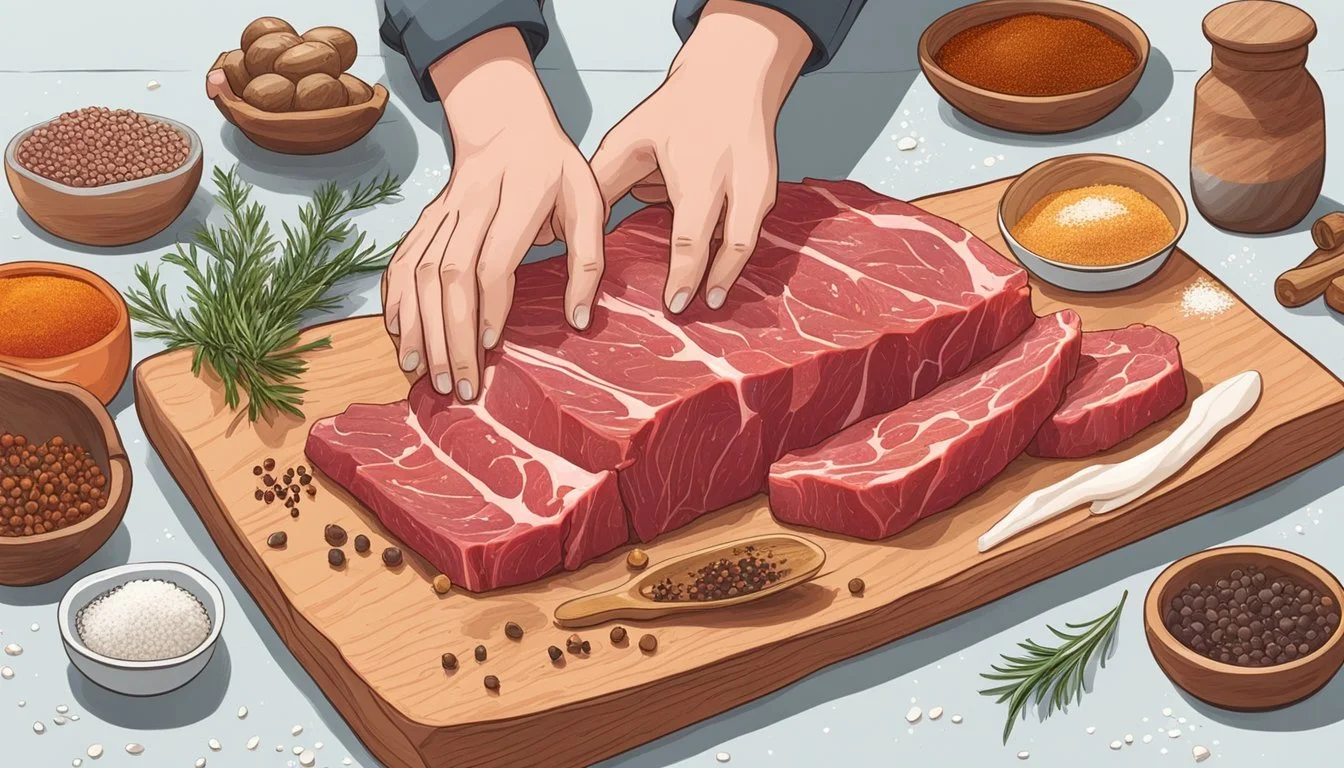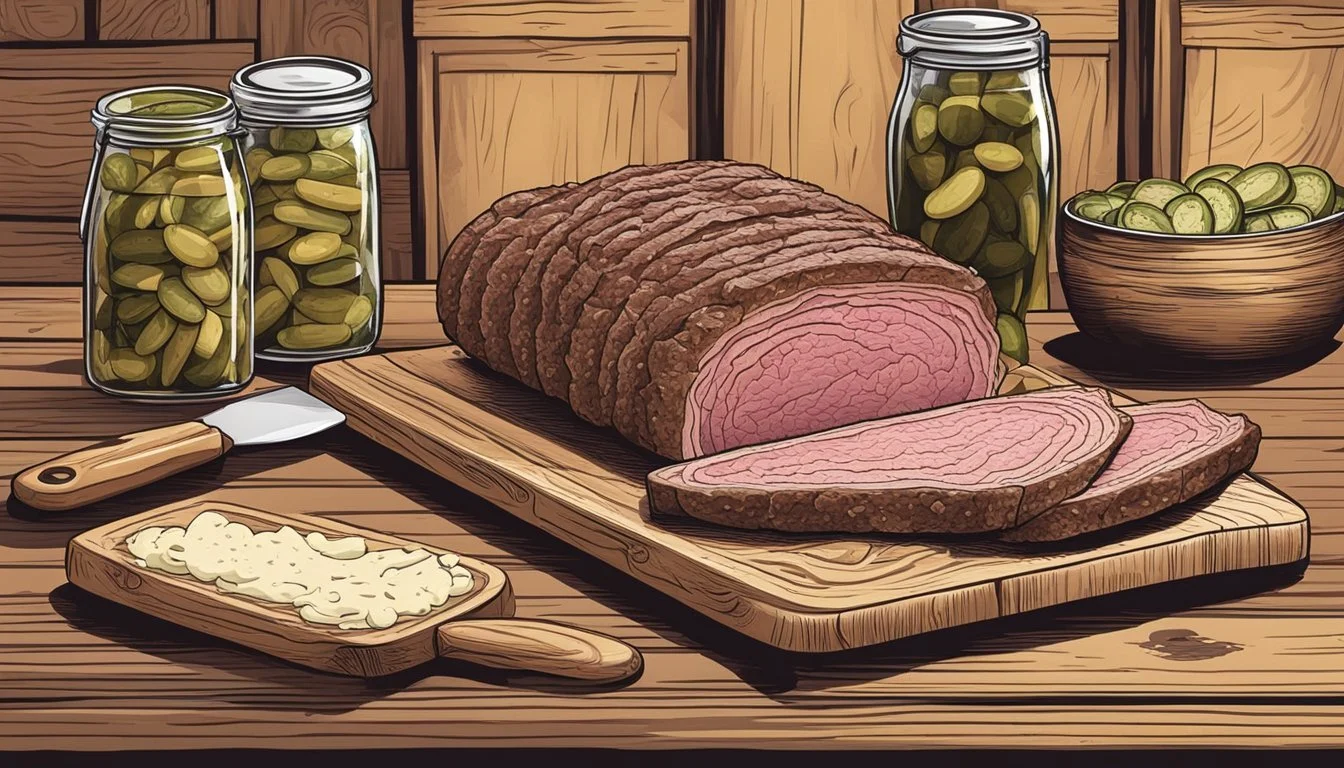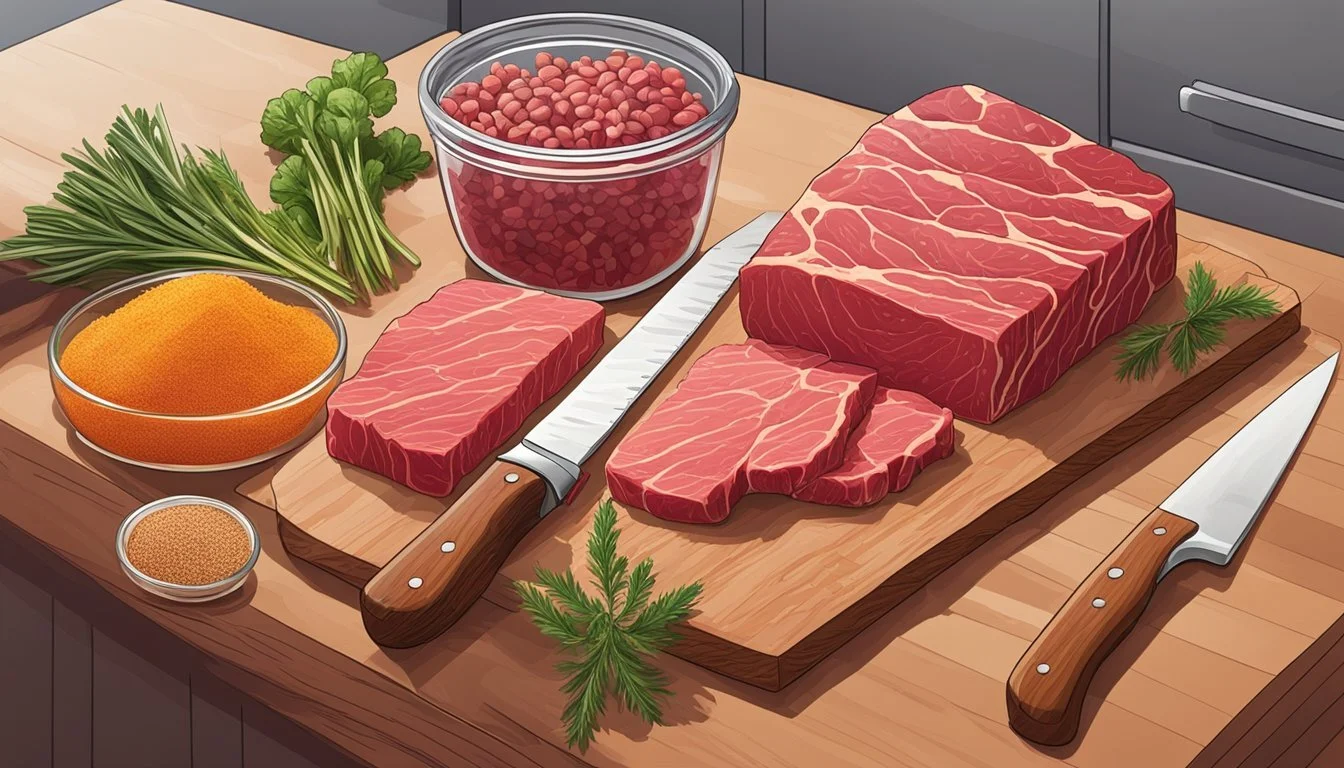DIY Corned Beef
A Comprehensive Guide to Home Curing Mastery
Corned beef (What wine goes well with beef?) is traditionally associated with St. Patrick's Day feasts and deli sandwiches (What wine goes well with sandwiches?), but it is also an exquisite example of the art of meat preservation through curing. Known for its savory, seasoned flavor and tender texture, corned beef begins as a simple brisket transformed by the curing process. Home curing allows individuals to tailor the taste to their liking and reassures them of the ingredients used in the process.
The process of home curing corned beef involves brining the beef brisket in a seasoned solution. This seasoned brine, typically a mix of water, salt, sugar, and various pickling spices, imparts the distinct flavors associated with corned beef. As part of the preservation, the brine's composition is crucial in drawing out moisture from the meat, which inhibits bacterial growth and enhances the beef's qualities.
Homemade corned beef requires patience as the brisket needs to marinate in the brine for several days. However, the result is a rewarding and flavorful cut of meat that can be served in countless ways. By mastering the home curing technique, individuals can enjoy a personal touch to this classic dish, ensuring a fresh and preservative-free corned beef that is both a tribute to tradition and a testament to DIY culinary skills.
Understanding Meat Curing
In the art of home curing, the preservation of meat is achieved through a meticulous process that involves the use of salt, regulating bacterial growth, and ensuring meat safety.
Curing Basics
Curing is the process of preserving meat to extend its shelf life, enhance flavor, and maintain moisture. It involves treating food with salt, sugar, and sometimes sodium nitrite, which serves as a preservative. Typically, the cure is a mixture of granulated salt, sugar, and curing salts, which may contain sodium nitrite. This compound is effective in preventing spoilage and maintaining the desired color of cured meats.
Role of Salt in Curing
Salt acts as the primary agent in meat curing, drawing moisture out which inhibits bacterial growth. It's essential in:
Preserving meat: Salt ensures that meat doesn't spoil over time.
Flavor development: Beyond preservation, salt imparts a distinct taste.
Table: Types of Salt Used in Curing
Name Also Known As Properties Sodium Chloride Table Salt Base component for moisture extraction Prague Powder №1 Pink Curing Salt, Curing Salt №1 Contains sodium nitrite for short-term cures Prague Powder №2 Curing Salt №2 Addition of sodium nitrate for long-term curing needs
Health and Safety in Curing
Safety in curing is paramount to prevent foodborne illnesses. Proper use of curing salts, with sodium nitrite, is crucial, as they serve a dual purpose: they preserve the meat and prevent the growth of Clostridium botulinum, the bacteria responsible for botulism. It's vital to:
Measure curing salts accurately: Incorrect amounts can affect both flavor and safety.
Cure meat at proper temperatures: Refrigeration is essential to slow bacterial growth during the curing process.
Selecting the Right Cut
Choosing the right cut of beef is the foundation of creating excellent corned beef. The ideal selection is crucial for flavor, texture, and overall quality.
Types of Beef Brisket
Beef brisket, deriving from the lower chest or breast of the cow, is the traditional choice for corned beef. There are two primary cuts to consider:
Flat Cut: Leaner than its counterpart, the flat cut is more uniform in thickness and ideal for slicing.
Point Cut: This cut is thicker, richer in fat, and has more marbling, which can lead to a more tender end product when cooked correctly.
Selecting between these cuts depends on personal preference and the end goal for texture and presentation.
Fat Content and Textural Considerations
The amount of fat and the texture of the meat are vital to the final taste and mouthfeel of corned beef.
Fat: While fat imparts flavor, too much can overwhelm the palate. Look for a brisket with a moderate amount of fat—it should have a layer of fat on one side and marbling throughout the muscle fibers.
Texture: The connective tissue within the brisket will break down during the curing and cooking processes, contributing to a tender final product. Choose meat with a clear definition of muscle fibers, indicative of quality and freshness.
Both the fat content and the texture of the brisket play significant roles in the corned beef's flavor profile and should be considered carefully during the selection process.
Preparing the Brine Solution
Prior to curing, one must pay meticulous attention to the brine preparation process as it is integral to the flavor and safety of the final corned beef product.
Brine Ingredients Overview
The composition of the brine is pivotal for the curing process. The basic ingredients include:
Water: Acts as the solvent base for the brine.
Salt: Regular table salt or kosher salt is used for flavor and to assist with curing.
Sugar & Brown Sugar: These sweeteners balance the salt's sharpness.
Pickling Spices: A blend usually consisting of bay leaves, cloves, and peppercorns.
Pink Curing Salt: Also known as Prague Powder or pink salt, it's essential for preserving the meat’s color and preventing spoilage.
One should ensure the correct proportions of each ingredient to achieve the desired taste and preservation needs.
Mixing and Boiling the Brine
For the brine mixture:
Combine approximately 1 gallon of water with the appropriate amount of salt, sugar and brown sugar in a large pot.
Heat the mixture over high heat, stirring to dissolve the crystalline components thoroughly.
Add pickling spices and continue to stir.
As the mixture approaches a boil, mix in the pink curing salt to incorporate it evenly throughout the brine.
Once the brine starts boiling, one should ensure that all the granules have fully dissolved before proceeding to the cooling phase.
Cooling and Refrigerating the Brine
After the brine has boiled and all ingredients are dissolved:
Remove the pot from the heat.
Introduce ice to expedite the cooling process, bringing the temperature of the brine down to 45°F (approximately 7°C) as swiftly as possible to safeguard against bacterial growth.
Transfer the cooled brine to a refrigerator, keeping it chilled until it is ready to be used.
This refrigeration step is critical, as it ensures the brine is at a safe temperature for the beef to be submerged and cured properly without the risk of foodborne illness.
Curing the Beef
Home curing transforms beef brisket into flavorful corned beef through a precise and attentive process. Each stage is critical to achieving the desired taste and texture.
Submerging the Beef in Brine
The beef brisket must be fully submerged in a seasoned brine—a mixture of water, curing salt, sugar, and pickling spices. To ensure an even cure, use a non-reactive pot or container, such as plastic or glass. One must carefully prepare the brine by boiling water with the ingredients, then cooling it with ice before adding the meat.
Essential Steps:
Prepare the brine: Dissolve curing salt and sugar into boiling water; add spices.
Cool the brine: Incorporate ice to expedite cooling.
Submerge the brisket: Ensure the meat is completely covered.
Duration and Temperature of Curing
The duration of curing typically spans several days, during which the brisket is left in the refrigerator. An extended and uninterrupted refrigeration period is critical for the curing process, allowing the brine to penetrate and preserve the meat thoroughly.
Curing Details:
Total time: Ranges from 5 to 7 days, depending on recipe specifics.
Temperature: Maintain a consistent refrigerator temperature below 40°F (4°C).
Rinsing and Preparing for Cooking
Once the curing time concludes, the corned beef requires rinsing under cold water to remove excess salt from the surface. Handling the meat gently and rinsing thoroughly sets the foundation for a successful cooking process, ensuring a balanced flavor profile.
Final Preparation:
Rinse: thoroughly in cold water to eliminate brine residue.
Cook: according to your chosen homemade corned beef recipe.
Cooking Techniques
After the corned beef has been cured, it's time to transform it into a tender and flavorful dish. Each cooking method can influence the texture and juiciness of the corned beef, so understanding these techniques is key to a successful dish.
Simmering the Corned Beef
The classic approach to cooking corned beef is to simmer it. One should place the corned beef in a large pot and cover it with water. Additional spices and aromatics can be added to the cooking liquid to enhance the flavor. The meat should be brought to a boil and then reduced to a low simmer. It typically takes about 50 minutes per pound to cook corned beef thoroughly through simmering. The corned beef is ready when it is fork-tender.
Using the Oven or Slow Cooker
Alternatively, one can cook corned beef in the oven or a slow cooker to achieve a more controlled and even cooking process. To cook in the oven, preheat it to 350°F. Place the corned beef in a roasting pan with some cooking liquid, cover it with foil, and bake for about 2 ½ to 3 ½ hours. For the slow cooker, one should place the corned beef, cooking liquid, and additional spices inside and cook on low for 8 to 10 hours or on high for 4 to 5 hours. Both methods result in tender corned beef and are especially useful when cooking larger briskets.
Alternative Cooking Methods
There are other methods to cook corned beef that may suit different preferences or available kitchen appliances. These include pressure cooking, which significantly reduces the total time, or grilling for a smoky flavor. However, these methods are less traditional and may require one to adjust their corned beef recipe or boiled dinner composition to ensure the meat cooks evenly and doesn't become dry or tough.
Serving and Pairing Suggestions
When presenting homemade corned beef, the complementary dishes and drink pairings play a vital role in crafting a memorable meal. This section offers guidance on traditional servings and innovative ways to enjoy this flavorsome meat.
Corned Beef and Cabbage Traditional Plate
The quintessential dish of Corned Beef and Cabbage is a staple for many, especially during St. Patrick's Day celebrations. To serve, one should:
Slice the homemade corned beef against the grain.
Pair with boiled cabbage, carrots, and potatoes.
Serve with a side of Irish soda bread.
Accompany with a pint of Guinness for a traditional Irish experience.
This combination adheres closely to the well-loved Irish culinary traditions, offering a comforting and hearty meal.
Incorporating Corned Beef into Sandwiches
Corned beef lends itself exceptionally well to sandwiches, providing a savory and substantial filling. The Reuben Sandwich is a well-known option, including:
Rye bread, toasted for crunch.
Layers of sliced corned beef.
Sauerkraut and Swiss cheese for tartness and depth.
A slathering of Russian dressing.
Toasted to perfection, this sandwich is a celebration of textures and flavors, ideal for a fulfilling lunch or casual dinner.
Creative Sides and Complements
Venturing outside the traditional, one can pair homemade corned beef with a variety of side dishes. Consider these options:
Roasted vegetables, such as brussels sprouts or parsnips, for a caramelized flavor complement.
A cold potato salad with a hint of mustard to balance the saltiness of the meat.
For a refreshing contrast, a crisp green salad dressed lightly with vinaigrette.
Whether served on a plate or as part of a sandwich, homemade corned beef can elevate any meal with its rich, savory notes. Select sides and beverages that enhance the core flavors for a truly satisfying dining experience.
Advanced Home Curing Topics
In the realm of home curing, enthusiasts can elevate their craft by exploring the infusion of unique spices, understanding the chemistry behind the appealing pink hue, and learning effective methods to preserve and store their homemade delicacies.
Experimenting with Spices and Flavors
For those looking to refine their corned beef, experimentation with spices and herbs is key. While traditional pickling spice—a blend that might include mustard seeds, allspice, and bay leaves—serves as a foundation, one can create distinctive flavors by introducing elements like coriander or green peppercorns. Notable authors such as Michael Ruhlman champion the use of kosher salt in the pickling mix, which, due to its purity and grain size, is ideal for the curing process.
Custom Spice Mix Sample:
2 tablespoons mustard seeds
1 tablespoon whole black peppercorns
1 tablespoon coriander seeds
2 teaspoons allspice berries
2 teaspoons red pepper flakes
8-10 bay leaves, crumbled
2 teaspoons whole cloves
Understanding the Science of Pink Color
The distinct pink color of corned beef is often acquired through the use of pink curing salt, also known as Prague Powder #1, which contains sodium nitrite that reacts with the meat's myoglobin. This reaction not only imparts the characteristic color but also inhibits bacterial growth. It is vital to distinguish this from pink Himalayan salt, which has no curing properties. The precise use of pink salt is essential as it affects flavor and safety.
Preserving and Storing Homemade Corned Beef
Once the curing phase is complete, proper storing becomes crucial for maintaining quality. Homemade corned beef can be stored in the refrigerator for up to a week, though wrapping and sealing are necessary to prevent spoilage. For extending shelf life further, vacuum-sealing and freezing are effective methods. Unlike store-bought options, homemade versions lack preservatives, which makes temperature control even more critical.
Storage Techniques:
Refrigerate: Wrap tightly in cling film, up to 1 week.
Freeze: Vacuum-sealed, up to 2 months for optimal quality.
Incorporating these advanced topics into the home curer's practice not only contributes to the depth of flavors one can achieve but also ensures a safe and enjoyable result akin to professional charcuterie (What wine goes well with charcuterie?). Whether one is aiming for a classic taste or venturing into a more personalized creation, understanding these elements can significantly enhance the home curing experience.
Health and Nutritional Information
When making corned beef, understanding its nutritional value and potential health implications is key to enjoying this cured meat in a balanced diet.
Caloric and Protein Content of Corned Beef
Corned beef is a source of protein, essential for muscle maintenance and overall health. A typical serving size (3.5 ounces or 100 grams) contains approximately 250 calories and 15 grams of protein, which varies slightly depending on the cooking method and the cut of the meat.
Potential Health Risks and Allergens
Corned beef contains sodium nitrite, a preservative used in curing. While sodium nitrite plays a role in preventing the growth of bacteria, there are claims regarding its potential health risks, such as being linked to increased cancer risk if consumed in high amounts. Individuals with allergies to any component used in the pickling or cooking process should exercise caution.
Vitamins and Minerals in Corned Beef
Corned beef provides a notable amount of certain vitamins and minerals. Key nutritional highlights include:
Selenium: Over 78% of the daily value in a 100-gram serving
Vitamin B12: About 68% of the daily value per 100 grams
Potassium: Beneficial for heart health
Vitamin C, Calcium, and Iron: Present in smaller amounts
Understanding these nutritional profiles can help individuals balance their intake and appreciate corned beef as part of a varied diet.





